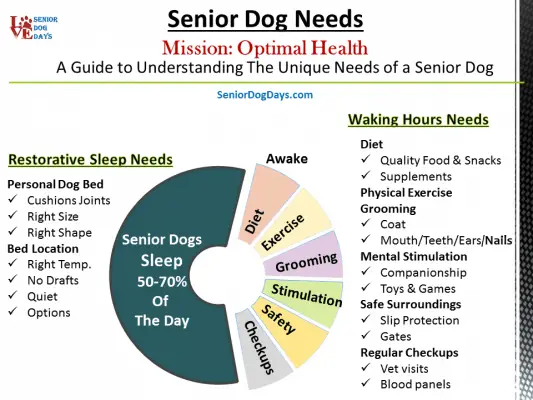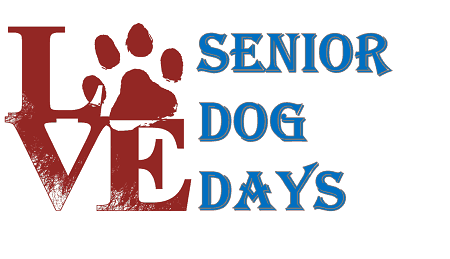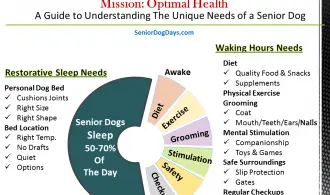Some content may contain affiliate links to products which means we could earn a fee on your purchase. Thank you for visiting
Taking care of a senior dog may seem scary, but rest assured knowing that millions of people have an aging dog in their home. Together, we help each other by sharing our experiences of living with our senior dogs.
For a quick reference, you can refer to the chart below. This senior dog chart answers the question: “what do senior dogs need” in an easy to understand format. Feel free to print it out for your own personal, in home use.
The best way to gain a better understanding of a senior dog’s needs, is by looking a little deeper into how our senior dog spends their day.
Let’s dive in –
Senior Dog Days: A Deeper Look at an Old Dog’s Day

As the chart shows, our senior dog will spend at least half of her day, usually a lot more, sleeping or resting. This is normal. So first we’ll talk about what she needs to get optimal rest and recovery while sleeping.
Then, we’ll move on and explore the other things our senior dog will need while she is awake. Usually, this is when you’re awake too so they are easy to implement once you establish a good routine.
Sleep Needs for Senior Dogs
As dogs age they require more sleep. Twelve to fifteen hours (or more) of sleep per day is not uncommon with our senior dogs and that means one thing:
Our Senior pups need a quality, right-sized bed.
Quality Beds Matter for Senior Dogs
Hardwood flooring, ceramic tiles and even wall to wall carpet shows no mercy on an older dog’s inflamed, aching, protruding joints and sleep comfort will be a senior dog’s top priority.
Senior dogs that are made to sleep on hard surfaces or inferior bedding will likely show a sharper decline in mobility and suffer pain and stiffness due to joint pain from lack of support. Other problems caused by insufficient bedding are calloused elbows (from getting up) and fur loss.
Make an effort to get your senior dog his very own comfortable bed and one that’s the right size. His bed should be long enough to contain him in a sprawled out sleeping position and about 2 times as wide as his girth.
If you are new to picking out dog beds, we have two extremely thorough guides when it comes to picking out dog beds for seniors. They are: Dog Bed Styles Explained (Orthopedic, Elevated, Bolster) and What to Look for in Orthopedic Dog Beds.
Senior Dog Bed Location
Once you have a nice bed for your senior dog, choose its location carefully. Make sure there are no drafty windows or baseboards that leak icy cold streams of air.
For a more thorough read on how sleep deprivation impacts our senior dogs: Read this Post About: Senior Dog Sleep
Now that we’ve got the major portion of our senior dog’s day as comfortable as possible, let’s move on to the portion of the day our senior dogs spend awake.
What Senior Dogs Need – While They Are Awake
This is the fun part because being with a senior dog feels great. They’ve learned a thing or two about chasing squirrels and definately have an advanced awareness when it comes to “worthy” treats.
We’re going to go through the topics listed on the chart for all the things you can do to make sure your senior dog stays in optimal health.
Some of these may be new to you, but I promise, nothing is too hard to handle. Like everything else, a little practice and getting into a routine will pave the way toward success.
Let’s dive in:
Senior Dog Grooming
Senior dogs will require some specialized grooming. They tend to get smellier faster and I think it’s because they sleep more. As they sleep, they drool and can’t help but get it all over their furry faces.
Mouth & Teeth – The time has come. If you’ve avoided brushing or wiping your dog’s teeth his entire life; the jig is up. If you fail to address mouth grooming, your senior dog will be unfairly labeled as having “old dog breath” and it won’t improve on its own.
Get a doggie toothbrush, dental wipes and start taking care of her mouth. For tips on helping to cure bad breath on a senior dog with DIY Dog Teeth Wipes and Pastes, Read This Post: Home Remedies for Senior Dog’s Bad Breath or learn how I turned in the toothbrush in exchange for the waterpick: Waterpik for Dog Teeth Article. You can actually watch a video of my dog and the waterpik.
Ears – Laying down all day means less air circulation to the ears and that means: stinky. Make ear cleaning a weekly routine. I have a very gentle ear cleaner from my veterinarian. It’s really inexpensive and its way better than the expensive formulas on the internet. You can read all about it here: My favorite gentle Ear Cleaner for dogs.
Coat – Since she’s sleeping more, her coat, especially hard to reach places, will mat more easily. A daily brushing will prevent mats from taking hold. To get a routine going, hang her doggie brush right at the door where she goes in and out for bathroom breaks. Use it once a day on her way inside.
Nails – As their daily activities begin to slow in pace and reduce in frequency, senior dog nail trimming is no longer accomplished naturally and must become part of regular grooming.
Neglecting nails can lead your senior dog to a downward spiraling trend affecting her comfort and mobility. For a thorough, in depth discussion on senior dog nail grooming, click here to read the nail grooming post.
Arthritic Dog Exercise
One of the best ways to keep a senior dog pain free and mobile is to keep her exercising. As they get older and start to slow down, you might get more benefit from breaking up the walks. For instance, if she’s diagnosed with arthritis, two (15) minute walks instead of a 30 minute walk can help alleviate stiffness.
On cold days or times when it’s too dangerous to walk, you have to do some inside activity; like an indoor treat scavenger hunt or stair climbing. Maybe even consider going to a pet-friendly store and walking the aisles.
For senior, arthritic dogs, a sedentary lifestyle is the enemy and YOU have control of her destiny.
Get moving!
Quality Diet for Older Dogs
Regular Food – Diets that lack nutrients or are filled with fillers are really just hunger suppressors and not doing much in the way of providing optimal health. Give your senior dog the highest quality food you can afford.
To this day, the very best thing I’ve ever done for my dog is 5 years ago; I stopped feeding him manufactured dog food. While the cost of the actual food for a raw diet isn’t all that much more than the grain-free, premium kibble and expensive canned food I was buying, the equipment and containers I purchased to make the job easier was several hundred dollars.
In the end though, the cost is justified by the fact that his raw diet cured his chronic skin condition, helped him lose 18 lbs he didn’t need and it solved his stinky dog problem.
I’ve saved thousands by eliminating vet bills and controversial steroid treatments. He has a fuller coat, no more diarrhea and he absolutely LOVES meal time.
Little by little, you can work toward making your dog’s life better. Buy the best quality food you can and don’t be afraid to prepare your dog’s food once in a while….or forever. I made a Beginners Guide for Feeding Senior Dogs RAW (link) if ever you become interested.
Little changes you can make to introduce nutrient rich foods that his body needs is a step in the right direction
Supplements – adding beneficial supplements that help lubricate joints and build cartilage can do wonders for a senior dog that’s suffering from inflammation. While it’s easy to buy chews and such, do know that you can use human grade supplements too.
In nearly all cases, the human grade supplements such as Glucosamine. Chondroitin and MSM cost less for a superior product. My senior dog has been taking human grade supplements for about 8 years. I Wrap them in some sticky cheese or peanut butter and he takes them happily. You can read our results with lots of arthritis products on the market: Products that work on my dog’s arthritis.
These are the products we review:

Stimulation
Your senior dog does not automatically stop needing or wanting mental stimulation when he’s older. More often than not, they decline in activity and seem “bored” because humans reduce play-time.
If you’ve got a tight schedule then consider mind-sharpening toys or DVD’s that are made especially to entertain a dog. These little improvements can do wonders for your senior dog’s mentality and help fill the gaps.
Talking to your dog, getting down to his level and giving good belly rubs all contribute to your senior dog’s well-being. This is also a great time to give tasty and beneficial treats and make him find them around the house.
Keep her stocked in toys, surprise her with new ones throughout the year and come home with doggy treats just because.
If you’re looking for original ideas to keep your senior dog mentally stimulated, you definitely have to check out this post: 10 Fun Things to do with an Older Dog
Safe Surroundings
If you think about it, the hazards facing a senior dog are similar to hazards facing elderly humans. One slip and fall is all it takes to set off a world of painful problems that impact mobility.
Now is the time to take a good look at your home and make supportive changes. Slippery hardwood floors, rugs that move, slick stairs or dangerous open staircases are not a good match for a senior dog.
Investing in rug gripping material, dog friendly throw rugs and staircase gates is an improvement that will make you both feel better. Remove sharp objects, electrical cords, and thread bare (holes in) bedding. These are all painful traps for an unsteady, senior dog. Here is yet another free guide that goes into great detail about helping a senior dog with arthritis at home (article)
And finally, our last topic is, of course: professional oversight.
Senior Dog Checkups
Vet Visits – As your senior dog progresses through senior hood, it becomes more and more important to have the regular checkups. Those aging diseases do not always show symptoms and some senior dogs are just way too good at hiding their pain. Six month checkups will help catch problems earlier.
Also, don’t be shy about having more than one veterinarian, especially if there are hundreds where you live. My dog has 3…well 4 if we include his eye specialist. Veterinarians do not require a retainer and it costs nothing to have your senior dog established with more than 1 professional
I like his holistic vet for nutritional reasons, his regular vet for blood, urine and routine stuff, and his clinic vet who specializes in annual services but spends a good 25 minutes looking over his entire body. These 3 veterinarians combine to make the perfect A-Team.
Summary
I hope after reading this you are encouraged to help your senior dog live a more comfortable life. Little steps completed over time can have huge benefits for you both. Enjoy each other!
Thanks for visiting SeniorDogDays!

